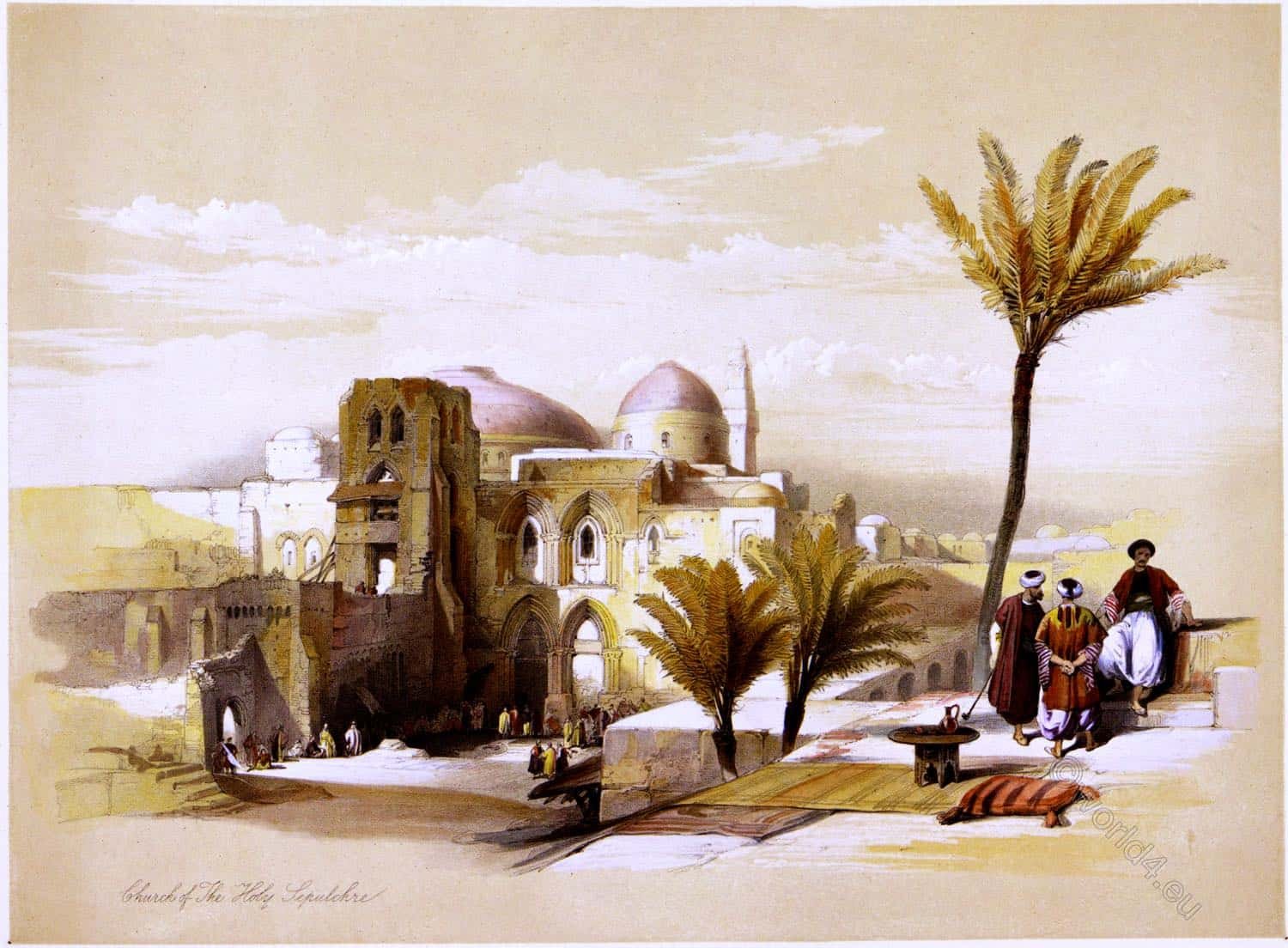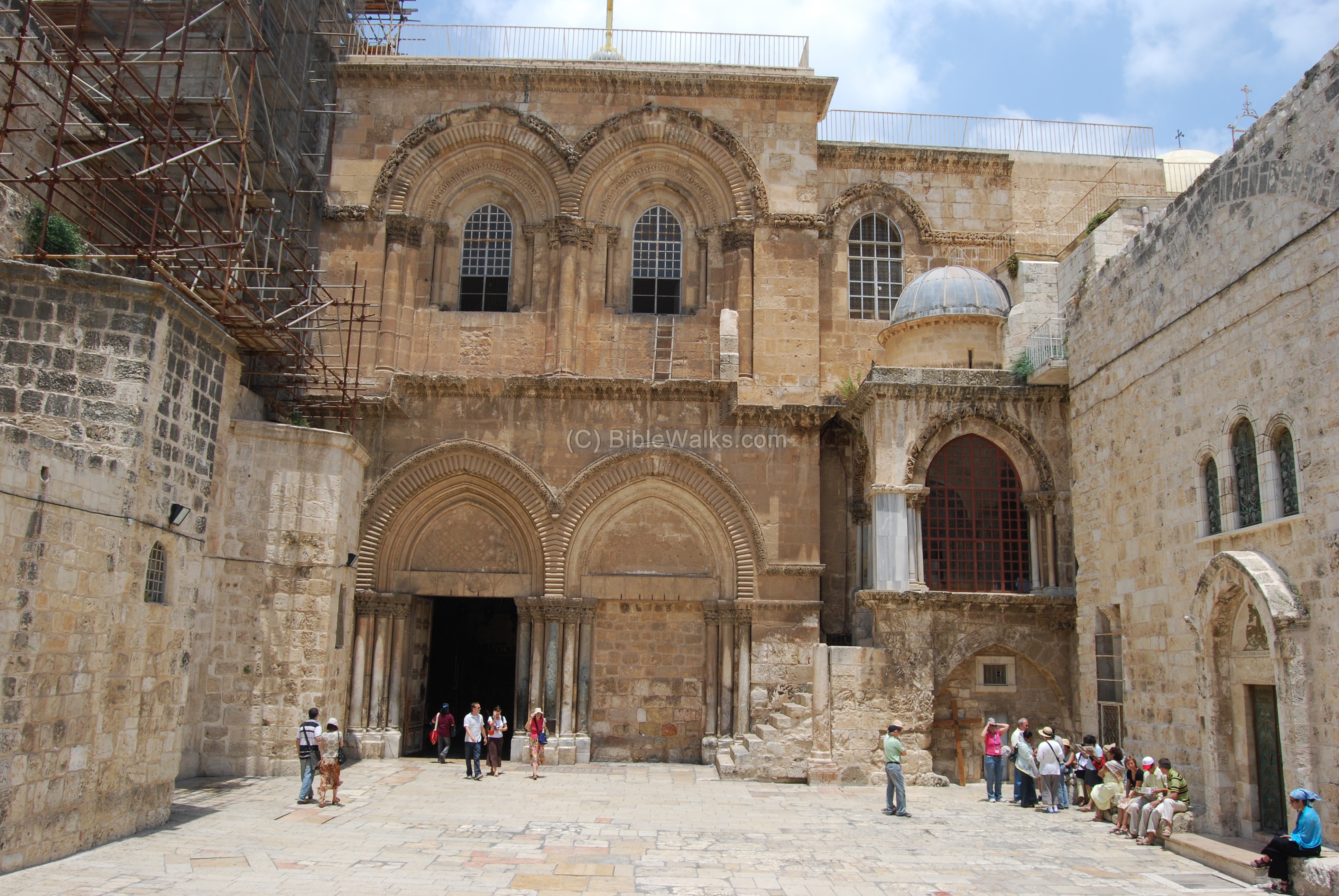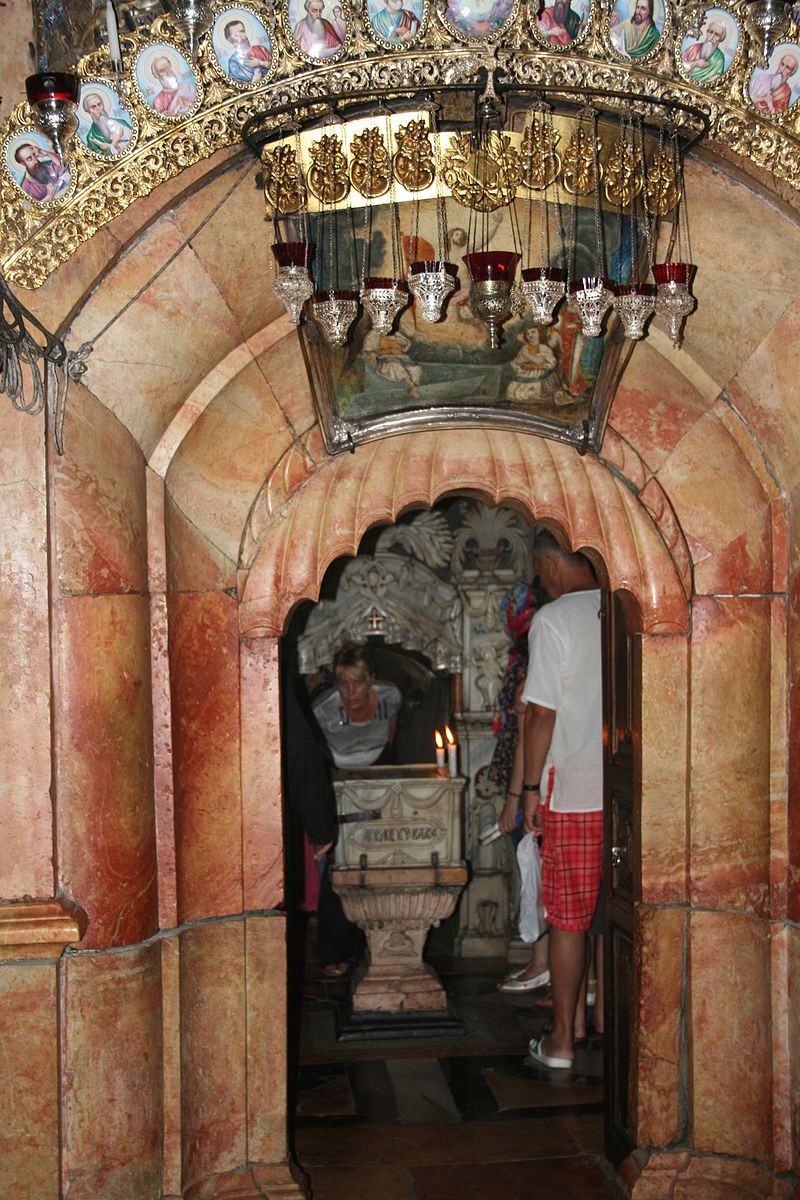Step into History: A Journey Through Jerusalem's Holy Sepulchre

Welcome, dear reader! In this blog post, we will discuss the Holy Sepulchre, which holds immense significance for Christians worldwide. We will be giving an overview of the Holy Sepulchre and why it is so important to believers. So, without further ado, let's dive into it!
Overview of the Holy Sepulchre and the significance to Christians
The Holy Sepulchre is a church located in the Old City of Jerusalem. It is believed to be the site where Jesus Christ was crucified, buried, and resurrected. The church stands on a hill previously called Golgotha, meaning "the place of the skull." This site is one of the most significant pilgrimage destinations for Christians worldwide.
The Holy Sepulchre is divided into different sections, each belonging to a different Christian denomination. The Greek Orthodox Church, the Roman Catholic Church, and the Armenian Apostolic Church are the primary custodians of the church. However, other communities also have a presence there, such as the Ethiopian Orthodox Church and Coptic Orthodox Church.
One of the most prominent sections of the Holy Sepulchre is the Stone of Anointing, where Jesus' body was believed to have been prepared for burial. Near the Stone of Anointing is a spot where Christ was supposedly crucified, known as Golgotha or Calvary. A few steps away from Golgotha is the Tomb of Christ, commemorating the empty tomb's Easter story.
For Christians, the Holy Sepulchre holds immense significance in history and spirituality. It is a place of pilgrimage where believers can experience a tangible connection to their faith. Visiting the Holy Sepulchre allows Christians to experience the reality of Christ's life, death, and resurrection. It serves as a reminder of the sacrifice made by Jesus Christ and the redemption he brought to humanity.
We hope this blog post has given you an insight into the Holy Sepulchre and its significance to Christians worldwide. It is indeed a remarkable and humbling experience for any Christian to visit the Holy Sepulchre and contemplate the life of Jesus Christ.

The Exterior of the Holy Sepulchre
If you can visit the Holy Sepulchre in Jerusalem, don't just focus on the impressive interiors. Make sure you take an outside tour of the church as well. The exterior of the Holy Sepulchre is an architectural masterpiece in its own right. This section will take you on a brief tour of its exterior, including the facade and courtyard.
Tour of the exterior of the Holy Sepulchre, including the facade and courtyard
The main entrance to the Holy Sepulchre is from the north through a large, ornately decorated doorway. Above the doorway is a statue of Mary, the mother of Jesus, holding him in her arms. On either side of the entrance are two towers topped by iron-clad domes.
You'll enter a large, open courtyard as you walk through the doorway. The courtyard is surrounded by arched walkways supported by massive columns. These led to various chambers and sections of the church. The courtyard is also dotted with olive trees, some of which are believed to be over a thousand years old.
On the eastern side of the courtyard is the beautiful facade of the Holy Sepulchre. The facade is an impressive mix of Romanesque, Gothic, and Renaissance architectural styles. It features intricate carvings, sculptures, and stained glass windows. The most striking feature is the grand rose window, which is a masterpiece of Gothic design.
One of the most interesting things about the exterior of the Holy Sepulchre is that it has undergone many changes and additions over the centuries. Each addition has been made by a different Christian denomination, which has led to a unique blend of architectural styles. It's fascinating to observe how each addition has contributed to the overall beauty and grandeur of the church.
The exterior of the Holy Sepulchre is a sight to behold. The ornate facade, the ancient olive trees, and the historic courtyard all contribute to the beauty and significance of the church. So, next time you visit the Holy Sepulchre, take a moment to appreciate its stunning exterior as well.

The Stone of Anointing
If you plan to visit the Holy Sepulchre, the Stone of Anointing is one of the most significant artefacts you'll see. This stone slab is located just inside the entrance of the church and is said to be the place where Jesus' body was laid after being taken down from the cross.
History of the Stone of Anointing and its role in the burial of Jesus Christ
The Stone of Anointing was not always a part of the Holy Sepulchre. It wasn't until the early 12th century that it was added to the church. The stone was brought from a nearby quarry and placed inside the church to commemorate the spot where Jesus was prepared for burial.
According to tradition, the body of Jesus was taken down from the cross and brought to a nearby tomb. There, his body was washed and anointed with oils and perfumes before being wrapped in linen and laid on the Stone of Anointing. This stone was then used to carry Jesus' body to its final resting place inside the tomb.
Over the centuries, the Stone of Anointing has been a source of controversy and conflict. In the 16th century, the Franciscan monks in the Holy Sepulchre were forced to cede control of the stone to the Greek Orthodox Church. This led to years of tension and violence between the two groups, with each claiming rightful ownership of the stone.
Today, Christians of all denominations consider the Stone of Anointing a holy site. Visitors to the Holy Sepulchre often kneel and pray beside the stone; some even touch it in the hope of receiving a blessing or healing.
The Stone of Anointing is an important part of the Holy Sepulchre's history and plays an important role in the burial of Jesus Christ. Its significance is recognized by Christians worldwide, and it continues to be a site of pilgrimage and prayer.

The Rotunda
If you plan on visiting the Holy Sepulchre in Jerusalem, you cannot miss the Rotunda, where the tomb of Jesus Christ is believed to be. The Rotunda is a circular structure with a diameter of about 33 meters. This impressive structure is adorned with various decorations and frescoes, showcasing the grandeur of the Byzantine era.
Exploration of the Rotunda, where the Holy Sepulchre is located and its architecture
As you enter the Rotunda, you'll notice its majestic dome, which rises to about 20 meters. The dome's interior is decorated with golden mosaics depicting various scenes from Jesus Christ's life. The walls of the Rotunda are adorned with paintings and frescoes depicting scenes from the Bible and the lives of the saints.
In the centre of the Rotunda, you'll see the Holy Sepulchre housed within a small shrine. The structure is said to contain the tomb where Jesus' body was laid after his crucifixion. The structure is guarded by two 16th-century marble columns built to protect the tomb from damage.
The Rotunda also features some interesting architectural elements, including the Crusader capitals that adorn the columns and arches. These capitals are carved with various biblical scenes and intricate designs that showcase the skill of the medieval craftsmen who created them.
Overall, the Rotunda is an impressive structure that serves as a testament to the faith and artistic achievements of the Byzantine era. Its beauty and historical significance make it a must-visit site for anyone interested in Christian history and architecture. So, if you're ever in Jerusalem, visit the Rotunda and experience its grandeur for yourself!

The Chapel of the Angel
History of the Chapel of the Angel and the significance of its name
If you ever visit the Holy Sepulchre in Jerusalem, you'll be blown away by its grandeur, history, and spiritual significance. One of the most unique and captivating sites within the Holy Sepulchre is the Chapel of the Angel, also known as the Chapel of the Apparition. This small and intimate chapel is located just outside the Aedicule, and it is believed to be the site where Jesus' resurrection was first announced by an angel to Mary Magdalene and the other women who visited the tomb.
The name of the chapel itself holds a special significance. The word "angel" comes from the Greek word "angelos," which means "messenger." According to Christian tradition, the angel who appeared to Mary Magdalene and the other women was a messenger of God, bringing them the good news of Jesus' resurrection. Therefore, the Chapel of the Angel is a tribute to this momentous event that changed the course of human history.
The Chapel of the Angel is significant for its historical and religious importance and its unique and beautiful architecture. The chapel is adorned with frescoes that date back to the 12th century, and its walls are covered with elaborate carvings and decorations that showcase the beauty and skill of the medieval craftsmen who created them. The chapel's interior is small and intimate, creating a peaceful and intimate space for prayer and reflection.
The Chapel of the Angel is a hidden gem within the Holy Sepulchre that offers visitors a unique and intimate experience of Christian history, spirituality, and artistic achievement. Its history and architecture make it a must-visit site for anyone interested in exploring Jerusalem's rich religious and artistic cultural heritage. So, if you're ever in Jerusalem, be sure to take a moment to visit the Chapel of the Angel and immerse yourself in its rich history and spiritual significance.

The Tomb of Jesus Christ
Tour of the Tomb of Jesus Christ and the surrounding area, including the Chapel of the Findings of the Cross
If you are a religious traveller, visiting Jerusalem may be on your bucket list. One of the most significant sites in this city is the Tomb of Jesus Christ. This tomb is located inside the Church of the Holy Sepulchre, one of the oldest surviving churches in the world.
When you visit the Tomb of Jesus Christ, you will see an area that contains two chambers and a stone tomb. The first chamber is known as the Chapel of the Angels and is believed to be where Jesus' body was washed after his crucifixion. The second chamber is where the actual tomb of Jesus is located. It is a small, enclosed area that can only be entered by a narrow opening less than a meter in height. Here, you can pay tribute to the tomb holding Christ's body for three days.
Apart from the Tomb of Jesus, another notable site in the Church of the Holy Sepulchre is the Chapel of the Finding of the Cross. This chapel is where the believed discovery of the True Cross took place - that is, the cross on which Jesus was crucified. The chapel is small and exquisitely designed, with stunning mosaics and frescoes giving visitors a glimpse into ancient Christian art.
A trip to Jerusalem is incomplete without a tour of the Tomb of Jesus Christ and other sacred Christian sites within the Holy Sepulchre. The site is a sight to behold and will leave you feeling humbled and awed by its rich biblical and historical significance.
Suppose you're looking for a spiritual and enlightening experience. In that case, the Tomb of Jesus Christ and the surrounding area, including the Chapel of the Finding of the Cross, are must-visit destinations. This site offers you a chance to experience a slice of religious history, marvel at the intricate art, and pay homage to the biblical figure of Jesus Christ.

The Aedicule
History and architecture of the Aedicule, the shrine that houses the Holy Sepulchre
If you're planning a visit to the Tomb of Jesus Christ in Jerusalem, one of the essential places to see is the Aedicule. This shrine, located inside the Church of the Holy Sepulchre, marks where Jesus Christ was placed after his crucifixion. The Aedicule is also the centrepiece of the holy site, and it's an amazing piece of religious architecture that showcases a blend of various traditions from the ancient world.
The Aedicule has become a symbol of the Holy Sepulchre as a whole. It is a small structure made of marble and decorated with inlays of mother-of-pearl and some small statues. The Aedicule is a rectangular base with a domed roof, representing the traditional structure of ancient Greek and Roman shrines. The interior of the Aedicule has undergone many changes over the centuries and has been destroyed and rebuilt many times.
The Aedicule survived over the centuries and underwent many changes, including fires, restorations, and fundamental structural modifications. The Greeks, Armenians, and Latins have all contributed to the Aedicule's architecture, with each group adding unique touches to the structure. The Aedicule perfectly represents early Christian architecture and its beauty lies in its combination of eastern and western elements.
The Aedicule is a must-visit location for any traveller interested in religious architecture and history. The shrine's beauty, the rich religious history associated with it, and the intricate design make it a must-see location. No trip to Jerusalem is complete without marvelling at the Aedicule's beauty and appreciating the architecture that has stood the test of time.

The Greek Orthodox Chapel of St. Longinus
Tour of the Greek Orthodox Chapel of St. Longinus and its significance
If you love exploring holy sites and learning about their historical and cultural value, the Greek Orthodox Chapel of St. Longinus is worth a visit. Located within the Church of the Holy Sepulchre in Jerusalem, this small chapel is dedicated to the Roman soldier who is believed to have pierced Jesus's side with a spear during the crucifixion.
As you enter the chapel, you'll be struck by its intricate artwork and murals. The chapel's walls are adorned with paintings depicting significant biblical events, including the Last Supper, the Crucifixion, and the Resurrection. The artwork is a beautiful representation of Byzantine art, and the intricate detail makes you feel like you've stepped back in time.
In addition to its beautiful artwork, the Greek Orthodox Chapel of St. Longinus is also significant because it stands where St. Longinus supposedly carried out the act that earned him his place in history. The chapel's location next to the Aedicule, the shrine that marks the location where Jesus was buried and resurrected, adds to its historical and religious significance.
While the chapel may be small, its historical and religious value is immeasurable. The Greek Orthodox Church has put much effort into preserving this holy site, ensuring it maintains its original architecture and charm. For example, the chapel's small stone entrance has remained intact despite the numerous fires and damages the Church of the Holy Sepulchre has sustained.
The Greek Orthodox Chapel of St. Longinus is a hidden gem inside the Church of the Holy Sepulchre that is worth visiting for anyone interested in early Christian and Byzantine art and history. Its walls, adorned with beautiful paintings and murals, transport you back in time, while its location and history make it a site of immense religious and historical significance. A visit to this small chapel is an experience that anyone will appreciate.
